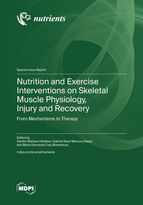Nutrition and Exercise Interventions on Skeletal Muscle Physiology, Injury and Recovery: From Mechanisms to Therapy
A special issue of Nutrients (ISSN 2072-6643). This special issue belongs to the section "Sports Nutrition".
Deadline for manuscript submissions: closed (15 September 2023) | Viewed by 33978
Special Issue Editors
Interests: insulin resistance; skeletal muscle metabolism; cell signaling; mitochondrial function; dietary supplements; physical exercise
Special Issues, Collections and Topics in MDPI journals
Interests: physical therapy; rehabilitation; nutrition; nutritional supplements; cancer; physical exercise training; human performance
Special Issues, Collections and Topics in MDPI journals
Interests: nutritional interventions; muscle physiology; muscle damage; inflammation; physical exercise; muscle recovery
Special Issue Information
Dear Colleagues,
The present Special Issue aims to join efforts towards the comprehension of the effects of nutrition and physical exercise on skeletal muscle physiology, injury, and recovery, using different experimental models (cells, animals, and humans) in both healthy and pathological conditions. Of particular interest, studies addressing cellular and molecular mechanisms involved in these processes, including energy metabolism, inflammatory pathways, oxidative stress regulation, mitochondrial function alteration, and gene expression control are welcome. We also welcome papers targeting the identification of cellular and molecular targets of nutritional interventions and physical exercise for the treatment and/or prevention of skeletal muscle injury and recovery.
Prof. Dr. Sandro Massao Hirabara
Prof. Dr. Gabriel Nasri Marzuca Nassr
Prof. Dr. Maria Fernanda Cury Boaventura
Guest Editors
Manuscript Submission Information
Manuscripts should be submitted online at www.mdpi.com by registering and logging in to this website. Once you are registered, click here to go to the submission form. Manuscripts can be submitted until the deadline. All submissions that pass pre-check are peer-reviewed. Accepted papers will be published continuously in the journal (as soon as accepted) and will be listed together on the special issue website. Research articles, review articles as well as short communications are invited. For planned papers, a title and short abstract (about 100 words) can be sent to the Editorial Office for announcement on this website.
Submitted manuscripts should not have been published previously, nor be under consideration for publication elsewhere (except conference proceedings papers). All manuscripts are thoroughly refereed through a single-blind peer-review process. A guide for authors and other relevant information for submission of manuscripts is available on the Instructions for Authors page. Nutrients is an international peer-reviewed open access semimonthly journal published by MDPI.
Please visit the Instructions for Authors page before submitting a manuscript. The Article Processing Charge (APC) for publication in this open access journal is 2900 CHF (Swiss Francs). Submitted papers should be well formatted and use good English. Authors may use MDPI's English editing service prior to publication or during author revisions.
Keywords
- physical exercise
- nutritional intervention
- inflammation
- oxidative stress
- metabolism
- molecular targets







